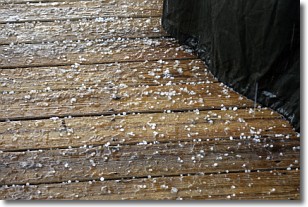Weather Alert in Texas
Flood Warning issued June 14 at 9:06PM CDT by NWS Houston/Galveston TX
AREAS AFFECTED: Houston, TX; Madison, TX; Trinity, TX; Walker, TX
DESCRIPTION: ...The Flood Warning continues for the following rivers in Texas... San Bernard River near Sweeny affecting Brazoria County. Trinity River near Crockett affecting Houston, Madison, Walker and Trinity Counties. Navasota River near Normangee affecting Grimes, Brazos and Madison Counties. ...The Flood Warning is extended for the following rivers in Texas... San Bernard River near Boling affecting Fort Bend, Wharton and Brazoria Counties. For the Trinity River...including Crockett, Riverside, Romayor, Goodrich, Moss Bluff, Liberty...Moderate flooding is forecast. For the Navasota River...including Normangee...Major flooding is forecast. For the San Bernard River...including Sweeny, East Bernard, Boling... Minor flooding is forecast. * WHAT...Minor flooding is occurring and minor flooding is forecast. * WHERE...Trinity River near Crockett. * WHEN...Until further notice. * IMPACTS...At 45.0 feet, Moderate lowland flooding begins in the vicinity of the gage impacting livestock grazing and prison farms. In past floods, problems occurred from the Highway 7 bridge downstream to Highway 21 bridge due to high flows in the backwater of Lake Livingston. * ADDITIONAL DETAILS... - At 8:45 PM CDT Saturday the stage was 42.0 feet. - Bankfull stage is 35.0 feet. - Recent Activity...The maximum river stage in the 24 hours ending at 8:45 PM CDT Saturday was 42.0 feet. - Forecast...The river is expected to rise to 44.6 feet early Thursday morning. Additional rises are possible thereafter. - Flood stage is 41.0 feet. - Flood History...This crest compares to a previous crest of 44.7 feet on 03/09/2001. - http://www.weather.gov/safety/flood
INSTRUCTION: Turn around, don't drown when encountering flooded roads. Most flood deaths occur in vehicles. Motorists should not attempt to drive around barricades or drive cars through flooded areas. Please report observed flooding to local emergency services or law enforcement and request they pass this information to the National Weather Service when you can do so safely. Additional information is available at www.weather.gov/hgx. The next statement will be issued Sunday afternoon at 315 PM CDT.
Want more detail? Get the Complete 7 Day and Night Detailed Forecast!
Current U.S. National Radar--Current
The Current National Weather Radar is shown below with a UTC Time (subtract 5 hours from UTC to get Eastern Time).

National Weather Forecast--Current
The Current National Weather Forecast and National Weather Map are shown below.

National Weather Forecast for Tomorrow
Tomorrow National Weather Forecast and Tomorrow National Weather Map are show below.

North America Water Vapor (Moisture)
This map shows recent moisture content over North America. Bright and colored areas show high moisture (ie, clouds); brown indicates very little moisture present; black indicates no moisture.

Weather Topic: What is Rain?
Home - Education - Precipitation - Rain
 Next Topic: Shelf Clouds
Next Topic: Shelf Clouds
Precipitation in the form of water droplets is called rain.
Rain generally has a tendency to fall with less intensity over a greater period
of time, and when rainfall is more severe it is usually less sustained.
Rain is the most common form of precipitation and happens with greater frequency
depending on the season and regional influences. Cities have been shown to have
an observable effect on rainfall, due to an effect called the urban heat island.
Compared to upwind, monthly rainfall between twenty and forty miles downwind of
cities is 30% greater.
Next Topic: Shelf Clouds
Weather Topic: What is Sleet?
Home - Education - Precipitation - Sleet
 Next Topic: Snow
Next Topic: Snow
Sleet is a form of precipitation in which small ice pellets are the primary
components. These ice pellets are smaller and more translucent than hailstones,
and harder than graupel. Sleet is caused by specific atmospheric conditions and
therefore typically doesn't last for extended periods of time.
The condition which leads to sleet formation requires a warmer body of air to be
wedged in between two sub-freezing bodies of air. When snow falls through a warmer
layer of air it melts, and as it falls through the next sub-freezing body of air
it freezes again, forming ice pellets known as sleet. In some cases, water
droplets don't have time to freeze before reaching the surface and the result is
freezing rain.
Next Topic: Snow
Current conditions powered by WeatherAPI.com




